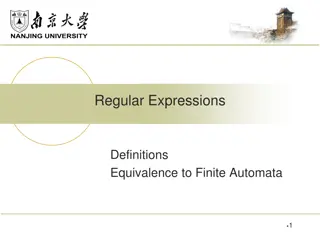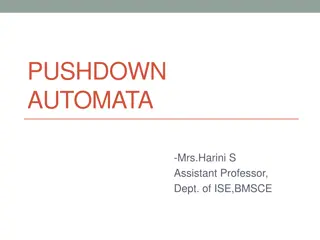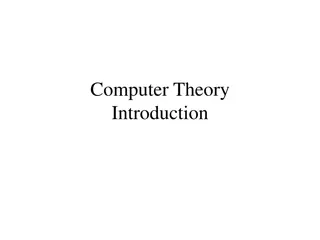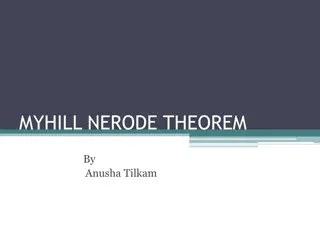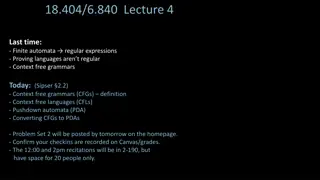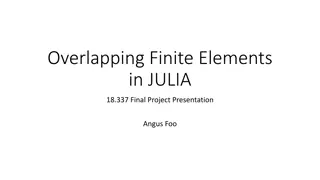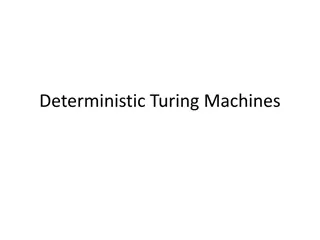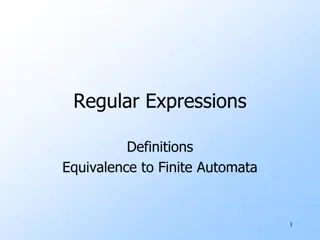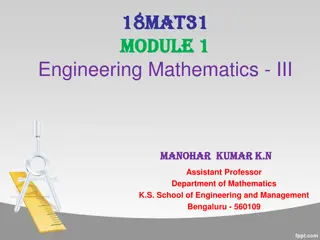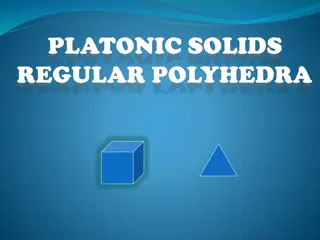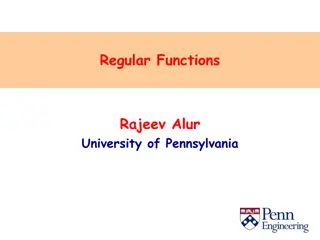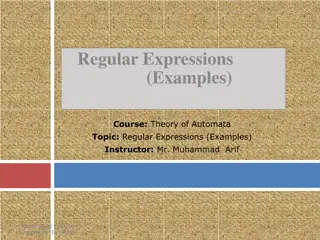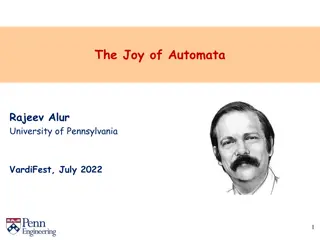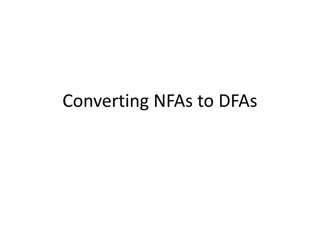Understanding Deterministic Finite Automata (DFA) in Regular Language Theory
An exploration of Deterministic Finite Automata (DFA) in the context of Regular Languages, covering their definition, functioning, application in recognizing input strings, and building a DFA for a specific language. The Chomsky Hierarchy and the significance of Regular Languages are also briefly discussed.
Download Presentation

Please find below an Image/Link to download the presentation.
The content on the website is provided AS IS for your information and personal use only. It may not be sold, licensed, or shared on other websites without obtaining consent from the author. Download presentation by click this link. If you encounter any issues during the download, it is possible that the publisher has removed the file from their server.
E N D
Presentation Transcript
Finite Automata Reading: Chapter 2 1
Finite Automaton (FA) Informally, a state diagram that comprehensively captures all possible states and transitions that a machine can take while responding to a stream or sequence of input symbols Recognizer for Regular Languages Deterministic Finite Automata (DFA) The machine can exist in only one state at any given time Non-deterministic Finite Automata (NFA) The machine can exist in multiple states at the same time 2
Deterministic Finite Automata - Definition A Deterministic Finite Automaton (DFA) consists of: Q ==> a finite set of states ==> a finite set of input symbols (alphabet) q0 ==> a start state F ==> set of accepting states ==> a transition function, which is a mapping between Q x ==> Q A DFA is defined by the 5-tuple: {Q, , q0,F, } 3
What does a DFA do on reading an input string? Input: a word w in * Question: Is w acceptable by the DFA? Steps: Start at the start state q0 For every input symbol in the sequence w do Compute the next state from the current state, given the current input symbol in w and the transition function If after all symbols in w are consumed, the current state is one of the accepting states (F) then accept w; Otherwise, reject w. 4
Regular Languages Let L(A) be a language recognized by a DFA A. Then L(A) is called a Regular Language . Locate regular languages in the Chomsky Hierarchy 5
The Chomsky Hierachy A containment hierarchy of classes of formal languages Context- Regular (DFA) Context- sensitive (LBA) Recursively- enumerable free (PDA) (TM) 6
Example #1 Build a DFA for the following language: L = {w | w is a binary string that contains 01 as a substring} Steps for building a DFA to recognize L: = {0,1} Decide on the states: Q Designate start state and final state(s) : Decide on the transitions: Final states == same as accepting states Other states == same as non-accepting states 7
Regular expression: (0+1)*01(0+1)* DFA for strings containing 01 Q = {q0,q1,q2} What makes this DFA deterministic? 0,1 1 = {0,1} 0 start state = q0 F = {q2} Transition table 1 0 start q0 q1 q2 Accepting state symbols 0 1 q1 q0 q0 What if the language allows empty strings? states q1 q2 q1 q2 q2 *q2 8
Example #2 Clamping Logic: A clamping circuit waits for a 1 input, and turns on forever. However, to avoid clamping on spurious noise, we ll design a DFA that waits for two consecutive 1s in a row before clamping on. Build a DFA for the following language: L = { w | w is a bit string which contains the substring 11} State Design: q0 : start state (initially off), also means the most recent input was not a 1 q1: has never seen 11 but the most recent input was a 1 q2: has seen 11 at least once 9
Example #3 Build a DFA for the following language: L = { w | w is a binary string that has even number of 1s and even number of 0s} ? 10
Extension of transitions () to Paths ( ) (q,w) = destination state from state q on input string w (q,wa) = ( (q,w), a) Work out example #3 using the input sequence w=10010, a=1: (q0,wa) = ? 11
Language of a DFA A DFA A accepts string w if there is a path from q0 to an accepting (or final) state that is labeled by w i.e., L(A) = { w | (q0,w) F } I.e., L(A) = all strings that lead to an accepting state from q0 12
Non-deterministic Finite Automata (NFA) A Non-deterministic Finite Automaton (NFA) is of course non-deterministic Implying that the machine can exist in more than one state at the same time Transitions could be non-deterministic 1 qj qi Each transition function therefore maps to a set of states 1 qk 13
Non-deterministic Finite Automata (NFA) A Non-deterministic Finite Automaton (NFA) consists of: Q ==> a finite set of states ==> a finite set of input symbols (alphabet) q0 ==> a start state F ==> set of accepting states ==> a transition function, which is a mapping between Q x ==> subset of Q An NFA is also defined by the 5-tuple: {Q, , q0,F, } 14
How to use an NFA? Input: a word w in * Question: Is w acceptable by the NFA? Steps: Start at the start state q0 For every input symbol in the sequence w do Determine all possible next states from all current states, given the current input symbol in w and the transition function If after all symbols in w are consumed and if at least one of the current states is a final state then accept w; Otherwise, reject w. 15
Regular expression: (0+1)*01(0+1)* NFA for strings containing 01 Why is this non-deterministic? Q = {q0,q1,q2} = {0,1} 0,1 0,1 start state = q0 F = {q2} Transition table 1 0 start q0 q1 q2 Final state symbols 0 1 {q0,q1} {q0} q0 What will happen if at state q1 an input of 0 is received? states {q2} q1 {q2} {q2} *q2 16
Note: Omitting to explicitly show error states is just a matter of design convenience (one that is generally followed for NFAs), and i.e., this feature should not be confused with the notion of non-determinism. What is an error state ? A DFA for recognizing the key word while q0 q1 w h i l e q2 q3 q4 q5 Any other input symbol qerr Any symbol An NFA for the same purpose: w h i l e q0 q1 q2 q3 q4 q5 Transitions into a dead state are implicit 17
Example #2 Build an NFA for the following language: L = { w | w ends in 01} ? Other examples Keyword recognizer (e.g., if, then, else, while, for, include, etc.) Strings where the first symbol is present somewhere later on at least once 18
Extension of to NFA Paths Basis: (q, ) = {q} Induction: Let (pi,a) = Si (q0,w) = {p1,p2 ,pk} for i=1,2...,k Then, (q0,wa) = S1 U S2 U U Sk 19
Language of an NFA An NFA accepts w if there exists at least one path from the start state to an accepting (or final) state that is labeled by w L(N) = { w | (q0,w) F } 20
Advantages & Caveats for NFA Great for modeling regular expressions String processing - e.g., grep, lexical analyzer Could a non-deterministic state machine be implemented in practice? Probabilistic models could be viewed as extensions of non- deterministic state machines (e.g., toss of a coin, a roll of dice) They are not the same though A parallel computer could exist in multiple states at the same time 21
Technologies for NFAs Micron s Automata Processor (introduced in 2013) 2D array of MISD (multiple instruction single data) fabric w/ thousands to millions of processing elements. 1 input symbol = fed to all states (i.e., cores) Non-determinism using circuits http://www.micronautomata.com/ 22
But, DFAs and NFAs are equivalent in their power to capture langauges !! Differences: DFA vs. NFA DFA All transitions are deterministic Each transition leads to exactly one state For each state, transition on all possible symbols (alphabet) should be defined Accepts input if the last state visited is in F Sometimes harder to construct because of the number of states Practical implementation is feasible NFA Some transitions could be non-deterministic A transition could lead to a subset of states Not all symbol transitions need to be defined explicitly (if undefined will go to an error state this is just a design convenience, not to be confused with non- determinism ) Accepts input if one of the last states is in F Generally easier than a DFA to construct Practical implementations limited but emerging (e.g., Micron automata processor) 1. 1. 2. 2. 3. 4. 3. 5. 4. 5. 23
Equivalence of DFA & NFA Theorem: A language L is accepted by a DFA if and onlyif it is accepted by an NFA. Proof: If part: Prove by showing every NFA can be converted to an equivalent DFA (in the next few slides ) Should be true for any L 1. Only-if part is trivial: Every DFA is a special case of an NFA where each state has exactly one transition for every input symbol. Therefore, if L is accepted by a DFA, it is accepted by a corresponding NFA. 2. 24
Proof for the if-part If-part: A language L is accepted by a DFA if it is accepted by an NFA rephrasing Given any NFA N, we can construct a DFA D such that L(N)=L(D) How to convert an NFA into a DFA? Observation: In an NFA, each transition maps to a subset of states Idea: Represent: each subset of NFA_states a single DFA_state Subset construction 25
NFA to DFA by subset construction Let N = {QN, , N,q0,FN} Goal: Build D={QD, , D,{q0},FD} s.t. L(D)=L(N) Construction: QD= all subsets of QN (i.e., power set) FD=set of subsets S of QNs.t. S FN D: for each subset S of QNand for each input symbol a in : 1. 2. 3. D(S,a) = U N(p,a) p in s 26
Idea: To avoid enumerating all of power set, do lazy creation of states NFA to DFA construction: Example L = {w | w ends in 01} 1 0 NFA: DFA: 0 1 0,1 [q0] [q0,q1] [q0,q2] 0 1 0 1 q2 q0 q1 0 1 D 0 1 D 0 1 N [q0] [q0,q1] [q0,q1] [q0,q1] [q0] [q0,q2] q0 {q0,q1} {q0} [q0] [q1] *[q2] {q0,q1} {q0} {q2} q1 {q2} *[q0,q2] [q0,q1] [q0] *q2 [q0,q1] {q0,q1} {q0,q2} *[q0,q2] {q0,q1} {q0} 0. Enumerate all possible subsets *[q1,q2] {q2} 1. 2. Retain only those states reachable from {q0} Determine transitions *[q0,q1,q2] {q0,q1} {q0,q2} 27
NFA to DFA: Repeating the example using LAZY CREATION L = {w | w ends in 01} 1 0 NFA: DFA: 0 1 0,1 [q0] [q0,q1] [q0,q2] 0 1 0 1 q2 q0 q1 0 1 N 0 1 D q0 {q0,q1} {q0} [q0] [q0,q1] [q0,q1] [q0,q1] [q0] [q0,q2] q1 {q2} *q2 *[q0,q2] [q0,q1] [q0] Main Idea: Introduce states as you go (on a need basis) 28
Correctness of subset construction Theorem: If D is the DFA constructed from NFA N by subset construction, then L(D)=L(N) Proof: Show that D({q0},w) N(q0,w} , for all w Using induction on w s length: Let w = xa D({q0},xa) D( N(q0,x}, a ) N(q0,w} 29
A bad case where #states(DFA)>>#states(NFA) L = {w | w is a binary string s.t., the kth symbol from its end is a 1} NFA has k+1 states But an equivalent DFA needs to have at least 2k states (Pigeon hole principle) m holes and >m pigeons => at least one hole has to contain two or more pigeons 30
Applications Text indexing inverted indexing For each unique word in the database, store all locations that contain it using an NFA or a DFA Find pattern P in text T Example: Google querying Extensions of this idea: PATRICIA tree, suffix tree 31
A few subtle properties of DFAs and NFAs The machine never really terminates. It is always waiting for the next input symbol or making transitions. The machine decides when to consume the next symbol from the input and when to ignore it. (but the machine can never skip a symbol) => A transition can happen even without really consuming an input symbol (think of consuming as a free token) if this happens, then it becomes an -NFA (see next few slides). A single transition cannot consume more than one (non- ) symbol. 32
FA with -Transitions We can allow explicit -transitions in finite automata i.e., a transition from one state to another state without consuming any additional input symbol Explicit -transitions between different states introduce non-determinism. Makes it easier sometimes to construct NFAs Definition: -NFAs are those NFAs with at least one explicit -transition defined. -NFAs have one more column in their transition table 33
Example of an -NFA L = {w | w is empty, or if non-empty will end in 01} 0,1 -closure of a state q, ECLOSE(q), is the set of all states (including itself) that can be reached from q by repeatedly making an arbitrary number of - transitions. 0 1 q0 q1 q2 start q 0 0 1 E ECLOSE(q 0) {q 0,q0} {q0} {q1} {q2} *q 0 q0 q1 *q2 {q0,q1} {q0} {q2} ECLOSE(q0) ECLOSE(q1) ECLOSE(q2) 34
To simulate any transition: Step 1) Go to all immediate destination states. Step 2) From there go to all their -closure states as well. Example of an -NFA L = {w | w is empty, or if non-empty will end in 01} 0,1 Simulate for w=101: 0 1 q0 q1 q2 q0 start q 0 q0 q0 1 1 q0 x 0 1 E 0 ECLOSE(q 0) q1 1 {q 0,q0} {q0} {q1} {q2} *q 0 q0 q1 *q2 {q0,q1} {q0} {q2} ECLOSE(q0) q2 35
To simulate any transition: Step 1) Go to all immediate destination states. Step 2) From there go to all their -closure states as well. Example of another -NFA Simulate for w=101: 0,1 ? 0 1 q0 q1 q2 1 start q3 q 0 0 1 E {q 0,q0,q3} {q0,q3} {q1} {q2} {q3} *q 0 q0 q1 *q2 q3 {q0,q1} {q0} {q2} {q2} 36
Equivalency of DFA, NFA, -NFA Theorem: A language L is accepted by some -NFA if and only if L is accepted by some DFA Implication: DFA NFA -NFA (all accept Regular Languages) 37
Eliminating -transitions Let E = {QE, , E,q0,FE} be an -NFA Goal: To build DFA D={QD, , D,{qD},FD} s.t. L(D)=L(E) Construction: QD= all reachable subsets of QE factoring in -closures qD= ECLOSE(q0) FD=subsets S in QDs.t. S FE D: for each subset S of QEand for each input symbol a : Let R= U E(p,a) 1. 2. 3. 4. p in s // go to destination states D(S,a) = U ECLOSE(r) closures r in R // from there, take a union of all their - Reading: Section 2.5.5 in book 38
Example: -NFA DFA L = {w | w is empty, or if non-empty will end in 01} 0,1 0 1 q0 q1 q2 start q 0 0 1 0 1 E D {q 0,q0} {q0} {q1} {q2} *{q 0,q0} *q 0 q0 q1 *q2 {q0,q1} {q0} {q2} 39
Example: -NFA DFA L = {w | w is empty, or if non-empty will end in 01} 0 0,1 0 {q0,q1} 0 1 {q0,q2} q0 q1 q2 0 1 0 1 1 start {q 0, q0} start q 0 q0 1 ECLOSE union 0 1 0 1 E D {q 0,q0} {q0} {q1} {q2} *{q 0,q0} {q0,q1} {q0} *{q0,q2} {q0,q1} {q0,q1} {q0,q1} {q0,q1} {q0} {q0,q2} {q0} {q0} *q 0 q0 q1 *q2 {q0,q1} {q0} {q2} 40
Summary DFA Definition Transition diagrams & tables Regular language NFA Definition Transition diagrams & tables DFA vs. NFA NFA to DFA conversion using subset construction Equivalency of DFA & NFA Removal of redundant states and including dead states -transitions in NFA Pigeon hole principles Text searching applications 41


